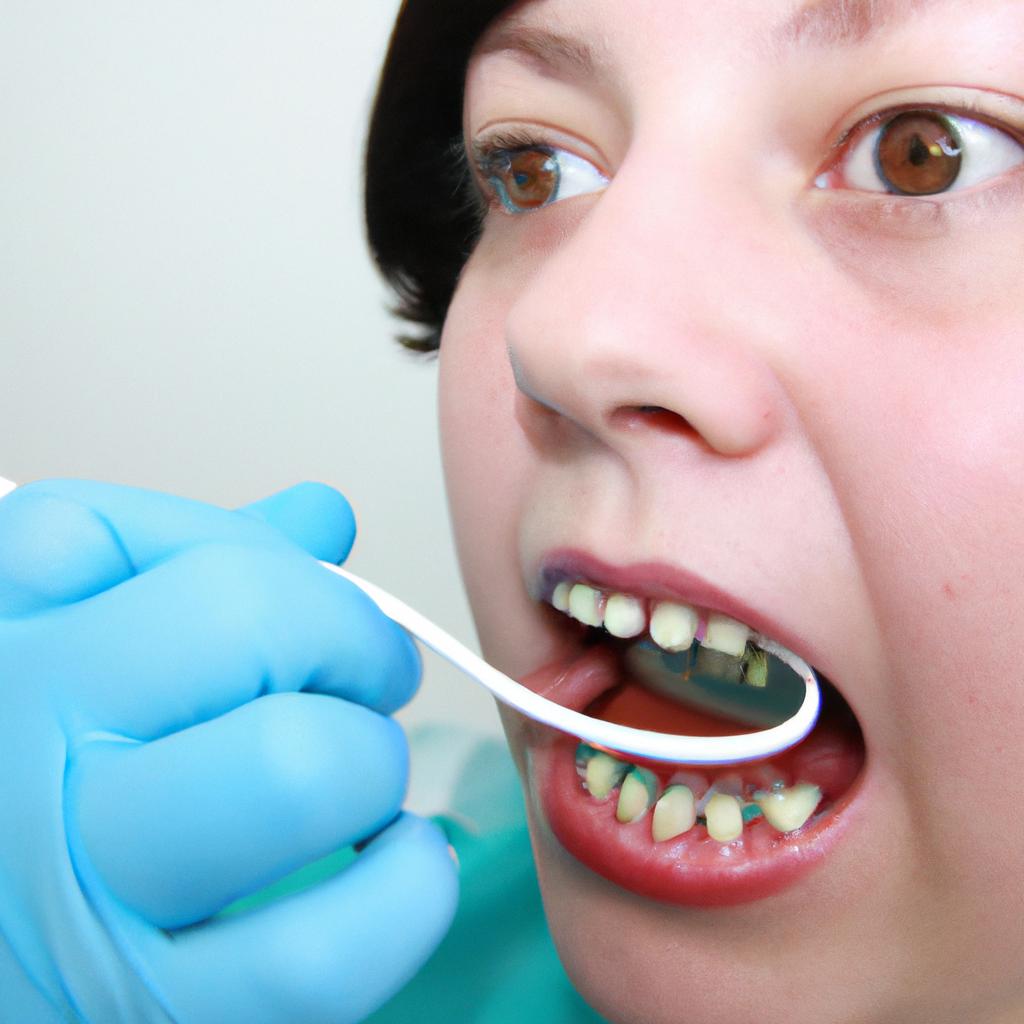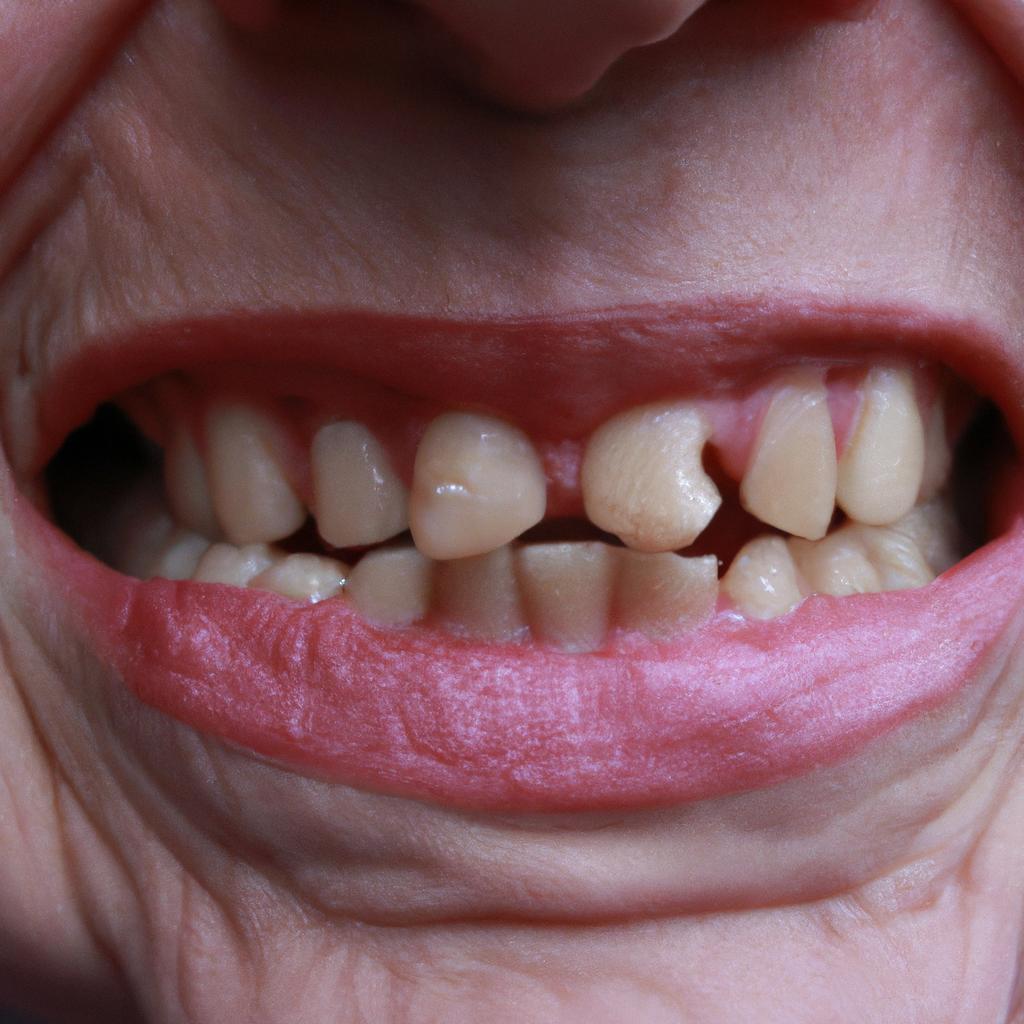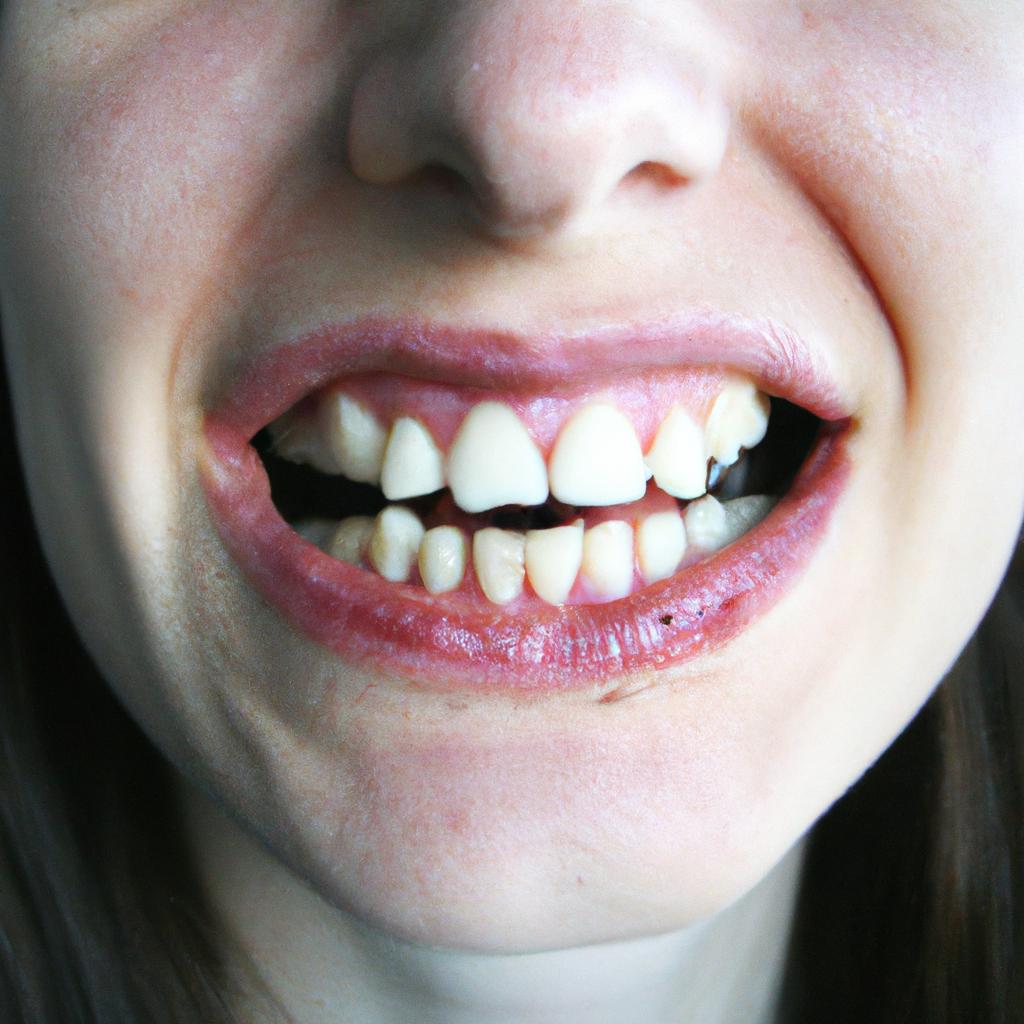Prosthodontics in Dentistry: A Comprehensive Specialization Overview

Prosthodontics in dentistry is a specialized field that focuses on the restoration and replacement of missing teeth. With advancements in technology and techniques, prosthodontists are able to provide comprehensive solutions for patients with complex dental problems. For instance, consider the case of Mr. Smith, who lost several teeth due to a traumatic accident. Through the expertise of a prosthodontist, he was able to regain his smile and functionality through the use of dental implants, fixed bridges, and removable prostheses.
In this article, we will delve into the world of prosthodontics in dentistry by providing a comprehensive overview of this specialization. We will explore the various aspects involved in prosthodontic treatment, including diagnosis, treatment planning, fabrication of restorations, and maintenance of oral health. Additionally, we will discuss the importance of interdisciplinary collaboration between prosthodontists and other dental professionals to achieve optimal outcomes for patients.
With an increasing demand for esthetic and functional rehabilitation among patients with missing or damaged teeth, understanding the role played by prosthodontics becomes crucial in modern dentistry. This article aims to shed light on this specialized branch by discussing its history, scope of practice, clinical procedures performed by prosthodontists, as well as the benefits and potential complications associated with prosthodontic treatment.
Prosthodontics has a rich history, dating back to ancient civilizations where primitive methods of tooth replacement were practiced. Over time, advancements in materials and techniques have revolutionized prosthodontics, allowing for more predictable and long-lasting results. Today, prosthodontists are highly trained specialists who work closely with patients to achieve their desired outcomes.
The scope of practice in prosthodontics is vast and encompasses various treatment modalities. These include fixed prostheses such as dental crowns, bridges, and implant-supported restorations. Removable prostheses like complete dentures or partial dentures may also be utilized depending on the patient’s needs. Prosthodontists are skilled in creating natural-looking smiles by considering factors such as tooth color, shape, size, and alignment to enhance facial aesthetics.
The process of prosthodontic treatment begins with a thorough diagnosis and treatment planning phase. This involves a comprehensive examination of the patient’s oral health, including an assessment of their remaining teeth, gums, jawbone structure, and overall occlusion (bite). Diagnostic tools such as X-rays, digital imaging, and intraoral scans may be used to aid in the evaluation.
Based on these findings, the prosthodontist will formulate a customized treatment plan tailored to each patient’s unique needs. The fabrication of restorations typically involves taking impressions or digital scans of the teeth to create models that serve as guides for designing and fabricating the final prostheses. Advanced technologies like computer-aided design/computer-aided manufacturing (CAD/CAM) systems are often employed to ensure precise fit and optimal esthetics.
Once the restorations are fabricated by dental laboratory technicians under the guidance of the prosthodontist, they are carefully placed in the patient’s mouth during subsequent visits. The fitting process ensures proper alignment and functionality, and adjustments may be made as necessary to achieve optimal comfort and function. Post-treatment care instructions are provided to the patient, including guidance on oral hygiene practices and regular dental check-ups.
Collaboration with other dental specialists is often necessary in complex cases involving multiple disciplines such as orthodontics, periodontics (gum treatment), or oral surgery. This interdisciplinary approach ensures that all aspects of the patient’s oral health are addressed comprehensively, resulting in successful outcomes.
While prosthodontic treatment can significantly improve a patient’s quality of life by restoring their ability to eat, speak, and smile confidently, it is important to acknowledge potential complications that may arise. These can include issues like implant failure, prosthetic loosening or fracture, gum inflammation, or bite discrepancies. Regular follow-up visits with the prosthodontist are essential for monitoring the long-term success of the restorations and addressing any concerns that may arise.
In conclusion, prosthodontics plays a vital role in modern dentistry by providing comprehensive solutions for patients with missing or damaged teeth. Through meticulous diagnosis, treatment planning, and fabrication of restorations, prosthodontists strive to restore both esthetics and functionality while ensuring long-term oral health. By collaborating with other dental professionals when needed, they maximize the chances of achieving optimal outcomes for their patients.
Complete Dentures: The Best Solution for Full Arch Tooth Replacement
Imagine a scenario where an individual has lost all of their teeth due to advanced periodontal disease. This condition not only affects their ability to chew and speak but also hampers their self-confidence, impacting various aspects of their daily lives. In such cases, complete dentures serve as the most effective solution for full arch tooth replacement. This section provides an overview of complete dentures, highlighting their significance in prosthodontics.
Benefits of Complete Dentures:
- Enhanced Functionality: Complete dentures enable individuals to regain the ability to eat and speak properly, improving overall oral health.
- Aesthetically Pleasing Appearance: By restoring facial contours and providing a natural-looking smile, complete dentures contribute significantly to enhancing one’s physical appearance.
- Psychological Well-being: With restored dental function and improved aesthetics, patients experience increased confidence and self-esteem, positively affecting their mental well-being.
- Improved Quality of Life: Complete dentures allow individuals to enjoy social interactions without feeling embarrassed or self-conscious about missing teeth.
Table: Emotional Impact of Complete Dentures
| Emotion | Before Wearing Complete Dentures | After Wearing Complete Dentures |
|---|---|---|
| Embarrassment | High | Low |
| Self-Consciousness | High | Low |
| Confidence | Low | High |
In summary, Complete Dentures play a vital role in prosthodontics by offering a comprehensive solution for full arch tooth replacement. From restoring functionality to enhancing aesthetics and boosting psychological well-being, these prosthetic devices have a profound impact on improving patients’ quality of life. However, it is important to note that while complete dentures offer numerous benefits, they are not suitable for everyone. Henceforth, we will explore another viable option for replacing missing teeth: removable partial dentures.
Removable Partial Dentures: A Removable Option for Missing Teeth
Section H2: Removable Partial Dentures: A Removable Option for Missing Teeth
Having explored the benefits of complete dentures as an effective solution for full arch tooth replacement, we now turn our attention to another viable option in prosthodontics — removable partial dentures. This section will delve into the characteristics and applications of removable partial dentures, shedding light on their role in restoring oral function and aesthetics.
Removable partial dentures offer a versatile approach to replacing missing teeth, particularly when only a few teeth are absent within an arch. For instance, consider the case study of Mr. Smith, a 55-year-old patient who had lost three posterior teeth due to decay. In this scenario, a dentist may recommend using a removable partial denture to restore his ability to chew properly while maintaining the esthetic appearance of his smile.
When considering the use of Removable Partial Dentures, it is important to understand their key features:
- Framework: The framework serves as the foundation of the denture and is typically made from metal or acrylic resin. Its purpose is to provide stability and support to the artificial teeth.
- Connectors: These components link different parts of the framework together, ensuring proper fit and retention.
- Artificial Teeth: Designed to closely resemble natural teeth, these prosthetic replacements enhance both functionality and aesthetic appeal.
- Retention Devices: Various mechanisms such as clasps or precision attachments help secure the removable partial denture in place.
To further illustrate the potential advantages of choosing removable partial dentures over alternative treatment options, let us examine some emotional responses that patients often report after undergoing this dental procedure:
- Increased self-confidence
- Improved speech clarity
- Restored ability to enjoy favorite foods
- Enhanced overall quality of life
Additionally, it is worth noting how this treatment compares with other prosthodontic alternatives:
| Treatment Options | Pros | Cons |
|---|---|---|
| Removable Partial Dentures | – Cost-effective option- Non-invasive procedure- Easily adjustable and repairable | – Potential for reduced stability compared to fixed alternatives- Requires regular maintenance and cleaning |
| Dental Implants | – Enhanced stability and durability- Improved oral health benefits | – Involves a surgical procedure with potential risks- Higher upfront cost- Not suitable for all patients |
| Fixed Dental Bridges | – Excellent esthetic results- Restored biting and chewing function | – Requires preparation of adjacent healthy teeth- Can be more expensive than removable partial dentures |
In summary, removable partial dentures provide a flexible treatment approach for patients missing only a few teeth within an arch. With their customizable framework, artificial teeth, and retention devices, these dentures offer numerous advantages in terms of functionality and aesthetics. By considering patient experiences and weighing the pros and cons against alternative options such as dental implants or fixed bridges, prosthodontists can guide individuals toward the most appropriate solution for their specific needs.
As we transition our focus to exploring fixed prosthodontics—a permanent solution for restoring both function and aesthetics—we will delve into the various techniques utilized in this field.
Fixed Prosthodontics: A Permanent Solution for Restoring Function and Aesthetics
Removable Partial Dentures (RPDs) provide patients with a flexible and cost-effective solution for replacing missing teeth. These custom-made appliances consist of artificial teeth attached to a metal or acrylic framework, which can be easily removed by the patient. RPDs are particularly suitable for cases where multiple adjacent teeth are missing, as they restore both function and aesthetics.
Consider the case of Mr. Johnson, a 55-year-old patient who had lost three posterior teeth due to severe decay. He was experiencing difficulty chewing and felt self-conscious about his smile. After an evaluation by a prosthodontist, it was determined that RPDs would be the most appropriate treatment option for him. The prosthodontist designed a removable partial denture specifically tailored to fit Mr. Johnson’s oral cavity, restoring his ability to chew effectively while improving his overall appearance.
When considering RPDs as a treatment option, it is important to note their advantages and disadvantages:
-
Advantages:
- Affordable alternative: RPDs tend to be more affordable than fixed prosthodontic options such as dental bridges or implants.
- Reversible option: As RPDs are removable, they offer flexibility in terms of maintenance and future modifications if needed.
- Preservation of remaining teeth: RPD frameworks provide support to the existing natural teeth, preventing them from shifting or further damage.
-
Disadvantages:
- Potential discomfort: Patients may experience initial discomfort when wearing RPDs until they become accustomed to them.
- Reduced stability: Compared to fixed prostheses, RPDs may have slightly less stability during chewing or speaking.
- Oral hygiene challenges: Proper cleaning of RPDs can require additional effort compared to maintaining natural teeth.
To illustrate these points further, consider Table 1 below outlining the pros and cons of using removable partial dentures:
| Pros | Cons |
|---|---|
| Affordable alternative | Initial discomfort |
| Reversible option | Reduced stability |
| Preservation of teeth | Oral hygiene challenges |
In summary, RPDs offer a removable and cost-effective solution for patients with missing teeth. While they may have some drawbacks, such as initial discomfort or reduced stability compared to fixed prostheses, the benefits often outweigh these concerns. Next, we will explore another specialized area in prosthodontics: Fixed Prosthodontics.
Transitioning smoothly into the next section about “Implant-Supported Prosthesis: The Modern Approach to Tooth Replacement,” it is essential to understand how advancements in dentistry have revolutionized tooth replacement options beyond traditional methods.
Implant-Supported Prosthesis: The Modern Approach to Tooth Replacement
Transitioning from the previous section on Fixed Prosthodontics, let us now delve into another significant aspect of prosthodontics: Implant-Supported Prosthesis. This modern approach to tooth replacement has gained immense popularity in recent years due to its ability to provide patients with a stable and long-lasting solution for missing teeth.
To illustrate the effectiveness of implant-supported prostheses, consider the case of Mr. Smith, a 50-year-old patient who had lost multiple teeth due to severe periodontal disease. Traditional dentures proved uncomfortable, unstable, and affected his ability to eat and speak confidently. Seeking an improved solution, he opted for an implant-supported prosthesis. Through meticulous planning and surgical placement of dental implants into his jawbone, a customized fixed bridge was securely attached to these implants. The result? Mr. Smith regained not only his oral function but also his self-esteem, as he could smile freely and enjoy meals without worrying about denture slippage.
Implant-supported prostheses offer several advantages over traditional removable dentures or fixed bridges supported by natural teeth:
- Stability: Dental implants integrate with the jawbone, providing a strong foundation that prevents movement or displacement of the prosthesis.
- Preservation of bone: Unlike traditional dentures that may lead to bone loss over time, implants stimulate the surrounding bone tissue, maintaining its volume and density.
- Improved chewing efficiency: With their stability and secure fit, implant-supported prostheses enable better biting forces compared to conventional options.
- Enhanced aesthetics: These prostheses are designed to closely resemble natural teeth in terms of color, shape, and size, resulting in a more natural-looking smile.
| Advantages of Implant-Supported Prostheses |
|---|
| Increased stability |
| Bone preservation |
| Improved chewing efficiency |
| Enhanced aesthetic appearance |
In conclusion
As we have explored the benefits of implant-supported prostheses, it is evident that this modern approach has revolutionized the field of prosthodontics. By providing patients with a stable and long-lasting solution for missing teeth, implant-supported prostheses significantly enhance oral function and aesthetics. In the subsequent section on Types of Complete Dentures: Understanding the Choices Available, we will explore another essential aspect of prosthodontics – complete dentures options and their suitability for different patient needs.
Transitioning to the subsequent section about “Types of Complete Dentures: Understanding the Choices Available,” let us now delve into an in-depth exploration of various alternatives for complete denture solutions without emphasizing any particular word or phrase.
Types of Complete Dentures: Understanding the Choices Available
Implant-Supported Prosthesis: The Modern Approach to Tooth Replacement has revolutionized the field of prosthodontics, offering patients a reliable and long-lasting solution for missing teeth. Now, let us delve into another important aspect of prosthodontics – understanding the choices available when it comes to complete dentures.
To illustrate this point, consider the case of Mr. Johnson, a 65-year-old patient who recently lost all his teeth due to advanced gum disease. He visited our dental clinic seeking a suitable tooth replacement option that would restore both function and aesthetics. After a thorough assessment by our prosthodontist, it was determined that he would benefit from complete dentures.
When considering complete dentures as an option for tooth replacement, several factors come into play:
-
Material Selection:
- Acrylic Dentures: These are cost-effective and easy to adjust but may be less durable than other materials.
- Porcelain Dentures: Known for their superior aesthetics and durability, these dentures require precise fitting but offer excellent results.
-
Design Options:
- Conventional Dentures: Fabricated once the gums have healed after tooth extraction.
- Immediate Dentures: Inserted immediately after tooth extraction with adjustments made over time as healing occurs.
-
Support Mechanisms:
- Overdentures: Utilize remaining natural teeth or dental implants for improved stability.
- Implant-Retained Dentures: Combines the benefits of implant-supported prostheses with removable complete dentures.
-
Maintenance and Care:
- Regular cleaning routines using specific denture cleansers and brushes.
- Periodic check-ups with the dentist for adjustments or repairs if necessary.
In summary, choosing the right type of complete denture involves careful consideration of various aspects such as material selection, design options, support mechanisms, and maintenance requirements. By tailoring treatment plans according to individual needs, prosthodontists can provide patients like Mr. Johnson with functional and aesthetically pleasing solutions.
Moving forward, let us explore the benefits of removable partial dentures in the next section: Benefits of Removable Partial Dentures: Convenience and Versatility. This alternative option offers a convenient and versatile approach to tooth replacement for individuals who have only a few missing teeth, providing them with an improved quality of life.
Benefits of Removable Partial Dentures: Convenience and Versatility
To further understand the benefits of these options, let’s delve into a real-life case study that showcases the impact complete dentures can have on improving oral function and quality of life.
Imagine Mrs. Johnson, an elderly woman who had been struggling with severe tooth loss due to advanced periodontal disease. She found it challenging to eat her favorite foods and was often self-conscious about her smile when interacting with others. After consulting with a prosthodontist, she opted for implant-supported overdentures as her preferred treatment option. This choice provided stability and improved retention compared to conventional complete dentures, allowing Mrs. Johnson to regain confidence in her ability to chew comfortably and speak clearly.
To better understand the choices available in complete denture treatments, consider the following emotional responses:
- Relief: Patients experience relief knowing that there are viable solutions for their dental issues.
- Empowerment: The availability of multiple options empowers patients to make informed decisions based on their unique circumstances.
- Improved self-esteem: By restoring oral function and aesthetics, complete dentures can significantly enhance a patient’s self-confidence.
- Enhanced social interactions: With restored oral health, individuals feel more comfortable engaging in conversations and participating in social activities.
Now, let’s explore this topic further by examining a table comparing two common types of complete dentures – conventional and implant-supported overdentures:
| Conventional Complete Denture | Implant-Supported Overdenture | |
|---|---|---|
| Stability | Relies solely on suction or adhesives | Supported by implants for increased stability |
| Bone preservation | May lead to bone resorption over time | Helps preserve bone structure |
| Chewing efficiency | May compromise chewing efficacy | Improved chewing ability |
| Longevity | Typically requires periodic adjustments | Offers greater durability and longevity |
As seen in the table, implant-supported overdentures offer distinct advantages over conventional complete dentures. This information enables patients to make informed decisions regarding their oral health and well-being.
Transitioning into our next section on fixed prosthodontics techniques that bridge gaps between teeth, we will explore another aspect of dental rehabilitation and restoration. By utilizing innovative approaches, prosthodontists can provide patients with long-lasting solutions for missing or damaged teeth.
Fixed Prosthodontics Techniques: Bridging the Gap between Teeth
Transition from the previous section:
Having explored the convenience and versatility offered by removable partial dentures, let us now delve into another essential aspect of prosthodontics in dentistry – fixed prosthodontics techniques. By employing these techniques, dental professionals are able to bridge the gap between teeth, restoring not only function but also aesthetics for patients with missing or damaged teeth.
Section: Fixed Prosthodontics Techniques: Bridging the Gap between Teeth
To illustrate the efficacy of fixed prosthodontics techniques, consider a hypothetical case study involving a patient who had lost two adjacent molars due to decay. The gaps left behind were affecting their ability to properly chew food and causing discomfort while speaking. Upon consultation with a prosthodontist, it was determined that a fixed dental bridge would be an appropriate treatment option in this scenario. This type of restoration involves anchoring artificial teeth (pontics) to neighboring natural teeth using crowns, thereby “bridging” the gap and providing stability and functionality.
Fixed prosthodontics offers several advantages over other treatment options:
- Long-lasting durability: Unlike removable dentures which may need periodic adjustments or replacements, fixed prosthetics are designed to be more resistant to wear and tear, offering long-term solutions for patients.
- Enhanced chewing efficiency: With stable artificial teeth securely anchored in place, individuals can enjoy improved bite force and overall comfort while eating.
- Aesthetically pleasing results: Fixed prostheses are custom-designed to match the color, shape, and size of surrounding natural teeth, ensuring a seamless blend within the patient’s smile.
- Preservation of oral health: By filling the gaps caused by missing or damaged teeth through fixed restorations like bridges or implants, potential problems such as shifting of remaining teeth or bone loss can be prevented.
| Advantages of Fixed Prosthodontics |
|---|
| Provides long-lasting durability |
| Enhances chewing efficiency |
| Achieves aesthetically pleasing results |
| Preserves oral health |
In summary, fixed prosthodontics techniques have revolutionized the field of dentistry by bridging gaps caused by missing or damaged teeth. Through the use of fixed dental bridges and other similar restorations, patients can regain their ability to chew effectively, restore aesthetics to their smiles, and maintain optimal oral health.
Transition sentence:
Looking ahead, we will now turn our attention to another aspect of prosthodontics – comparing implant-supported prostheses with traditional dentures in terms of functionality and effectiveness.
Implant-Supported Prosthesis vs. Traditional Dentures: A Comparison
Building on the principles of fixed prosthodontics techniques, which involve bridging the gap between teeth using dental prosthetics, this section aims to explore another popular approach in modern dentistry – implant-supported prosthesis versus traditional dentures. By comparing these two options, we can gain a deeper understanding of their benefits and drawbacks, helping patients make informed decisions regarding their oral health.
To illustrate the differences between implant-supported prosthesis and traditional dentures, let’s consider the case of Mr. Johnson, a 60-year-old patient who lost all his natural teeth due to severe periodontal disease. After thorough examination and consultation, Mr. Johnson was presented with both treatment options for consideration.
Firstly, implant-supported prosthesis offers several advantages over traditional dentures:
- Improved stability and functionality: Implants provide a stable foundation for replacement teeth, allowing individuals like Mr. Johnson to regain proper chewing function.
- Enhanced aesthetics: With implants closely mimicking natural tooth roots, they offer superior aesthetic results compared to removable dentures.
- Preservation of jawbone structure: Unlike traditional dentures that may contribute to bone loss over time, implants stimulate bone growth through osseointegration.
- Long-term durability: When well-maintained, implant-supported prostheses have proven to be more durable than conventional dentures.
However, it is important to note some considerations when opting for an implant-supported prosthesis:
- Cost implications: The initial investment required for implants tends to be higher than that of traditional dentures.
- Surgical procedure involved: Placing dental implants involves minor surgery under local anesthesia or sedation, which might not be suitable for all patients.
- Healing time and integration process: Osseointegration typically takes several months before attaching the final prosthetic restoration onto the implants.
In contrast, traditional dentures present their own set of advantages:
- Affordability: Dentures are generally more cost-effective than implant-supported prostheses.
- Non-invasive treatment: Unlike the surgical procedure required for implants, denture placement is non-invasive and can be completed relatively quickly.
- Suitable for patients with compromised jawbone structure: Individuals who lack adequate bone volume for dental implants may find removable dentures to be a viable option.
As Mr. Johnson weighed these factors, he ultimately decided that an implant-supported prosthesis would provide him with the best long-term solution in terms of function and aesthetics. However, each patient’s circumstances differ, so it is crucial to consult with a prosthodontist to determine the most appropriate treatment plan based on individual needs and considerations.
Transition into subsequent section about “Maintaining Complete Dentures: Tips for Long-lasting Wear”: With the decision made regarding his choice of treatment, Mr. Johnson eagerly sought guidance on maintaining complete dentures for optimal longevity and comfort.
Maintaining Complete Dentures: Tips for Long-lasting Wear
Implant-Supported Prosthesis: A Revolutionary Alternative
Imagine a patient named John who had been struggling with traditional dentures for years. Despite regular adjustments and relines, his dentures often caused discomfort while eating or speaking, affecting his overall quality of life. Frustrated by these challenges, he sought an alternative solution that would provide stability and confidence in his daily activities.
Implant-supported prosthesis emerged as the answer to John’s concerns. This innovative dental treatment involves the placement of titanium implants into the jawbone, which serve as secure anchors for prosthetic teeth. Unlike traditional dentures that rely on adhesives or suction to stay in place, implant-supported prostheses offer unparalleled stability and functionality.
One key advantage of implant-supported prosthesis over traditional dentures is its ability to preserve bone structure. When natural teeth are lost, the underlying jawbone can begin to deteriorate due to lack of stimulation. Implants address this issue by simulating tooth roots and promoting healthy bone growth around them.
To further understand the benefits of implant-supported prosthesis, consider the following:
- Enhanced Comfort: The stable support provided by implants eliminates issues such as slipping or clicking that many individuals experience with conventional dentures.
- Improved Speech: With a securely anchored prosthesis, patients regain their speech clarity without worrying about their teeth shifting during conversation.
- Increased Confidence: Being able to eat tough or chewy foods without discomfort allows individuals to enjoy a wider range of dietary choices, leading to improved self-esteem.
- Longevity: Properly cared for implant-supported prostheses have shown remarkable longevity compared to traditional dentures, providing durable solutions for oral rehabilitation.
| Benefit | Description |
|---|---|
| Stability | Implant-supported prostheses offer superior stability compared to conventional dentures, ensuring better function and comfort while performing daily tasks. |
| Bone Preservation | By stimulating the jawbone like natural tooth roots, implants help prevent bone loss over time and maintain facial structure. |
| Aesthetics | Implant-supported teeth closely resemble natural teeth in appearance, providing patients with a restored smile that looks and feels authentic. |
| Convenience | Unlike removable dentures that require regular removal for cleaning, implant-supported prostheses can be cared for just like natural teeth, simplifying oral hygiene routines. |
Considering the numerous advantages of implant-supported prosthesis, it is important to explore whether this treatment option aligns with your specific needs and circumstances. The subsequent section will delve into key considerations when determining if an implant-supported prosthesis is the right choice for you.
Considerations for Implant-Supported Prosthesis: Is It Right for You?
Building upon the importance of maintaining complete dentures for long-lasting wear, it is crucial to consider alternative options that may better meet individual needs and expectations. One such option is an Implant-Supported Prosthesis, which offers enhanced stability and functionality compared to traditional removable dentures.
Implant-supported prostheses have revolutionized dental care by providing patients with a more permanent solution for missing teeth. Let us explore some key considerations when determining if this treatment modality is suitable:
-
Bone Density and Quantity:
- Adequate bone density and quantity are essential for successful osseointegration, where the implants fuse with the jawbone.
- A thorough examination using advanced imaging techniques will help determine whether there is enough bone support available or if additional procedures, such as bone grafting, are necessary.
-
Oral Health:
- Good oral hygiene habits are pivotal in ensuring the longevity of implant-supported prostheses.
- Patients must be committed to regular dental visits, meticulous daily cleaning around the implants, and following professional recommendations for maintenance.
-
General Health Considerations:
- Certain medical conditions, like uncontrolled diabetes or autoimmune disorders, may affect the success rate of implant placement.
- Collaboration between a patient’s general physician and prosthodontist is crucial to assess their overall health status before proceeding with implant treatment.
-
Financial Implications:
- Implant-supported prostheses often involve higher initial costs than traditional dentures due to surgical procedures and materials used.
- Patients should weigh these expenses against the long-term benefits offered by improved function, aesthetics, and durability.
| Pros | Cons |
|---|---|
| Enhanced Stability | Surgical Procedure Required |
| Improved Chewing Efficiency | Higher Initial Costs |
| Natural Appearance | Potential Need for Additional Treatment |
| Longevity & Durability | Requirements for Good Oral Hygiene |
Implant-supported prostheses can significantly improve the quality of life for individuals with missing teeth. However, it is important to consult with a prosthodontist who specializes in implant dentistry to evaluate whether this treatment option aligns with your specific needs and circumstances.
By carefully considering factors such as bone density, oral health, general well-being, and financial considerations, you can make an informed decision regarding the suitability of an implant-supported prosthesis. Remember that each case is unique, and collaborating closely with dental professionals will ensure personalized care tailored to your individual requirements.




